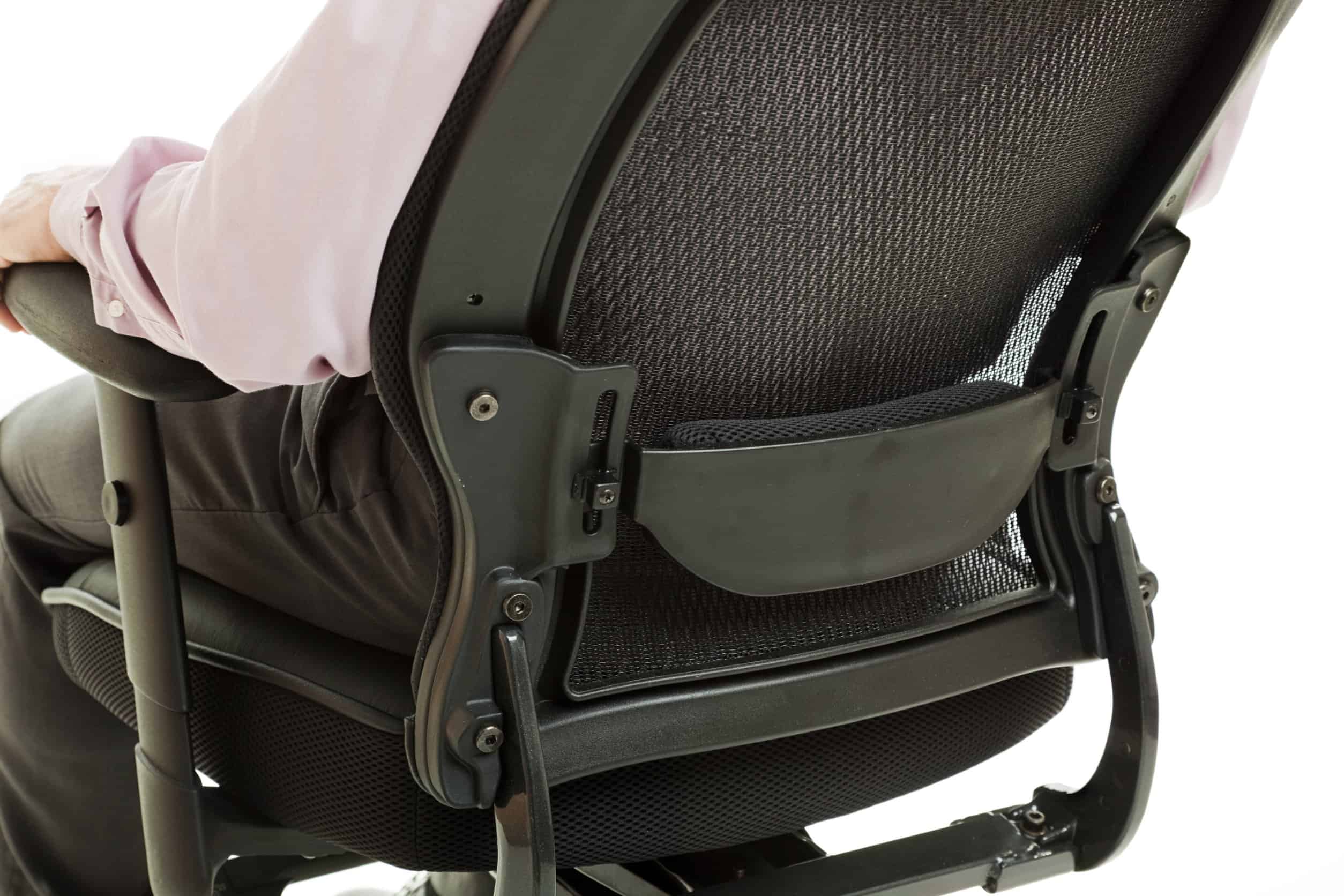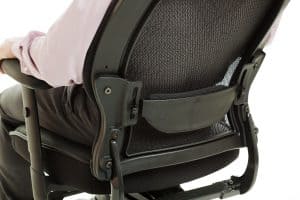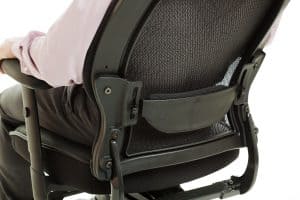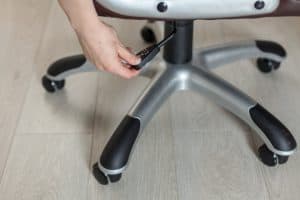In 2016, in the U.S, around 40% of people had a sitting job, meaning they spent more than 8 hours sitting at a desk – a number that’s probably increased a lot by now. So, it’s not surprising that back pain is among the leading causes of disability worldwide. What can people do to counter the adverse effects of prolonged sitting?
One solution has been to improve chair designs, so they can better fit the anatomy and structure of our bodies. Following that trend, Bill Stumpf and Don Chadwick pioneered a chair design in the 90s: the famous Aeron Chair, with a ‘pellicle’ mesh back that follows the spine’s natural curve. This was a major turning point for office chair designs that became the industry standard. Today, almost every office chair on the market has lumbar support.
However, not everyone knows why lumbar support became such an important concept for ergonomics and how exactly it works. Many people think lumbar support is uncomfortable and hurts their back instead of helping it. So, let’s clear the air and explain how lumbar support works.

What Is Lumbar Support?
In simple terms, the concept of lumbar support can be summed up as support for your lower back. The word “lumbar” is used in anatomy to describe the abdominal segment of the torso or the spinal vertebrae between the ribs and the pelvis.
Therefore, lumbar support is a part of the furniture, such as a chair or a car seat, that supports the natural curvature of the lower back. It’s designed to force the back to stay in a more natural position so you can maintain a proper posture while sitting
Lumbar support can be incorporated within the furniture structure – think of office chairs with a curved backrest or small pillows attached to the chairs’ back.
For a more detailed explanation, read our article What Is Lumbar Support? In the meantime, let’s explain how a pillow or a curved backrest on a chair can help the back.
How Lumbar Support Works
Now that we know what lumbar support is and its main function – to provide support for the lower back – we might ask how exactly does a curved backrest help our back?
The Anatomy of the Lumbar Spine
If you look at an illustration of a normal spinal alignment, you’ll notice that our spine is not flat or straight – it’s curved. To be more specific, the human spine has four curves – two of which are lordotic (inward), and two are kyphotic (outward).
Sitting affects all of these curvatures, but it has a most detrimental impact on the lordotic curve of the lower back, i.e., the lumbar curve.
Try to imagine how your posture changes when you sit. When we stand, the spinal section in our lower back has a slight inward curve – toward the front. But, when we sit, the lower back extends, and the curve disappears or decreases.
Sitting Decreases the Normal Lumbar Curve
Being able to increase and decrease the angle of the spinal vertebrae allows us to be flexible and freely move our body from side to side as well as to lean backward and forward. However, flexibility without stability results in poor posture.
To put it simply, a sedentary lifestyle and occupational demands create constant pressure toward a more slouched position: the head protruding forward, rounded shoulders, closed chest, and a forward tilting pelvis. This is the typical poor posture of modern people, and it results in weak muscles and a lack of body awareness. This is evident in both sitting and standing positions.
Sitting puts the lumbar curve under intense pressure. Our weak muscles and poor sitting posture intensify this pressure, especially when we sit for a prolonged time. Unfortunately, most people do not have the strength nor mental awareness to sit straight with the head, shoulders, and pelvis aligned.
The result is the straightening of the lumbar curve (rounded back), which with time, leads to many health problems (we will discuss in the next sections).
Lumbar Support Lessens the Decrease of the Lumbar Curve
The occupational demands and psychological stress impair our ability to focus on maintaining a correct posture while sitting. Even if we realize and correct our slouching posture, we’ll go back to a position that feels effortless to maintain in just a few minutes.
So, instead of expecting people to keep their back strength for hours, which is exhausting, furniture design with lumbar support mimics the natural curve and artificially forces people to correct their posture while sitting.
In other words, when the chair has a curved backrest or a pillow position on our lower back, it prevents or lessens the lumbar curve decrease caused by prolonged sitting.
Now, some of you might wonder: why is the decrease of the lumbar curve so bad if our spine is flexible and able to move or stay in different positions?
Why Is the Decrease of the Lumbar Curve so Bad?
Leaning forward and extending the lumbar spine for short periods is not bad. In fact, when we exercise, we repeatedly move the spine from a compressed to an extended position. But, exercise is dynamic, while sitting is static.
Sitting keeps the spine in an unnatural position for a long time, creating continuous pressure and stress on the spine’s muscles, nerves, and bones. Muscles become stiff, bones start rubbing on each other, and nerves get pinched.
Imagine holding a glass of water. It’s almost an effortless activity that feels very natural. However, if we hold a glass of water for 8 hours straight every day, we’ll experience many adverse effects: stiffness, bones cracking, limited mobility, and even pain in our arms.
The same thing happens to our back when we sit for hours. If we were to sit for a couple of minutes or even an hour or two, we probably wouldn’t care if the chair didn’t have lumbar support – we wouldn’t be in it long enough to notice. However, since we sit for hours, having lumbar support is essential.
Let’s look at the data to understand the importance of lumbar support better.
The Importance of Lumbar Support
We have said that prolonged sitting affects the spine negatively and results in many physical, psychological, and even financial problems. But, do you know the extent to which these problems occur in our society?
Around 16 million adults in the U.S suffer from chronic back pain. That’s 8% of all Americans (not counting children), which makes chronic back pain one of the most costly conditions in the US.
Chronic back pain causes people to lose work days, reduces life quality, and severely limits their everyday activities.
Therefore, investing in a chair with a high-quality lumbar support design is one of the most important things you can do for yourself.
In 2013, a group of scientists tested the effects of a lumbar support pillow during a prolonged seated task. They observed and measured subjective and objective indicators of comfort in healthy individuals and patients with low back pain during a 30-minute sitting task. Half of the participants were sitting in a standard office chair, while the other half sat in a chair with a lumbar support pillow. Results showed that the chair with a lumbar support pillow decreased lumbar flattening and increased the curvature of the lumbar spine, making participants more comfortable.
Although not surprising, the findings above go against the subjective feelings of some people who’ve used chairs with lumbar support and find it uncomfortable. So, before we conclude, let’s explain why lumbar support sometimes feels uncomfortable and how to avoid this.
How to Maximize the Benefits of Lumbar Support When Sitting?
It’s not uncommon for people to say that furniture with lumbar support feels uncomfortable or even painful. There are three probable reasons for this: they feel sore because the lumbar support corrects a position their body is used to, they don’t use the lumbar support right, or the particular lumbar support is not suitable for their body.
We should acknowledge that bad posture does not feel bad. The consequences are severe and unpleasant, but slicing, keeping the neck forward, or rounding the back is more relaxing for our muscles than flexing them to keep the body straight. Therefore, some soreness is expected before good posture becomes a habit.
Having said that, you should also understand that being uncomfortable is not the standard. If you feel pain when using lumbar support, you should ask yourself whether you’re using it correctly.
Typically, you should position your lumbar support pillow just above the belt line – where your back naturally curves toward the front. Also, keep in mind that your back should always rest on the backrest, and your weight should be toward the back. Keep the shoulders down and back and the neck relaxed. Finally, don’t forget to take frequent breaks to move your body and stretch.
If nothing helps and you still feel unnatural or uncomfortable after following our advice, then you might have an unsuitable chair for your back. This is why high-quality office chairs come in various sizes and with lumbar support suitable for all people. You could also invest in a separate lumbar support pillow that you can position manually based on the natural curve of your back.
Conclusion
Lumbar support is not just another trend that will eventually go out of style – it’s a necessary technology that lessens the negative effects of prolonged sitting. It supports the natural curve of your lumbar spine and prevents lumbar flattening. This is very important because lumbar flattening may lead to weak and stiff muscles, pinched nerves, chronic back pain, neck pain, limited movement, and even functional disability.
So, to avoid expensive treatments, pain, and psychological distress, be mindful of how and how much you sit. And, whenever you can’t avoid sitting for a prolonged time, make sure you have a chair with lumbar support that follows the natural alignment of your spine.
More importantly, choose the right chair for your size and height.





